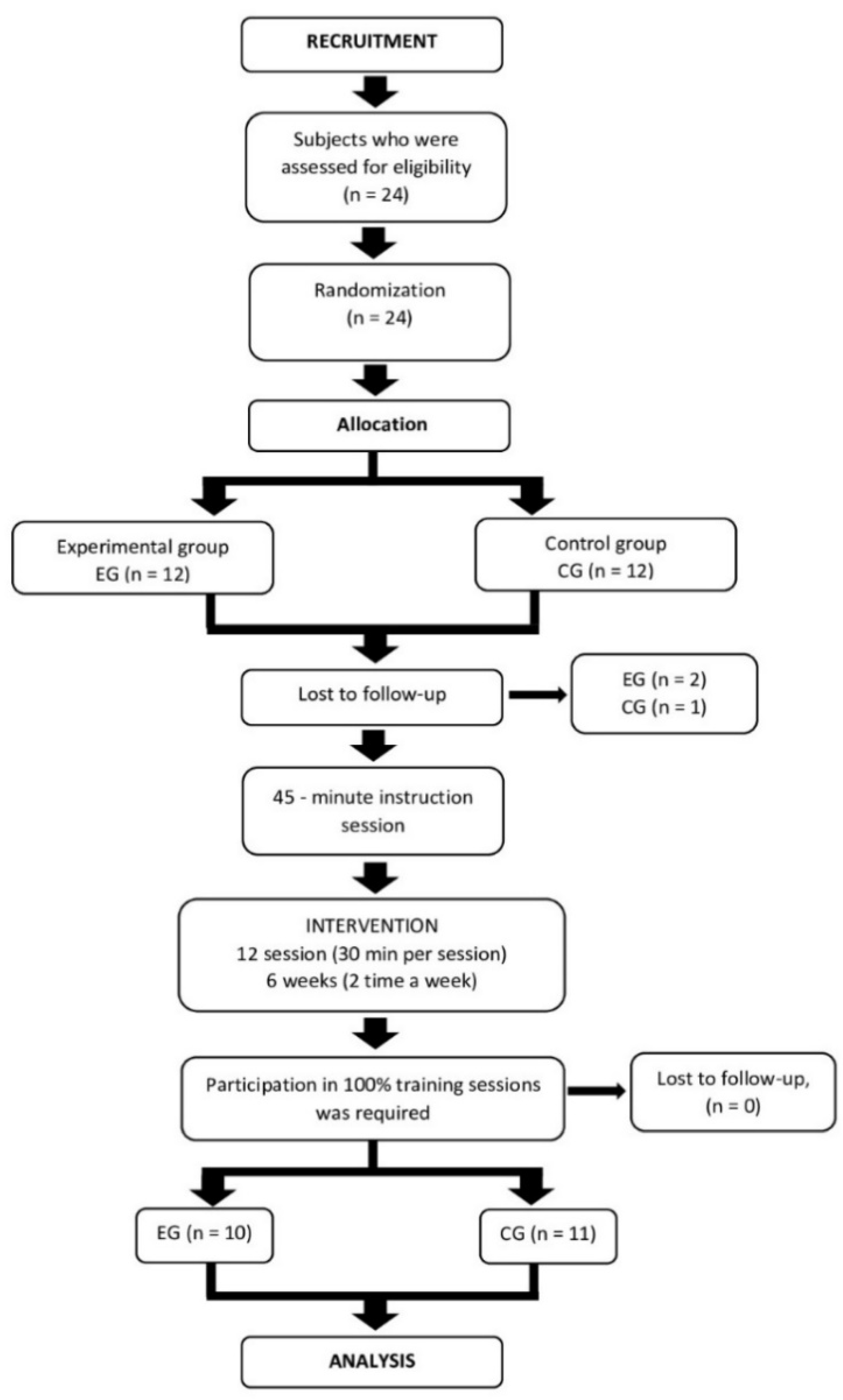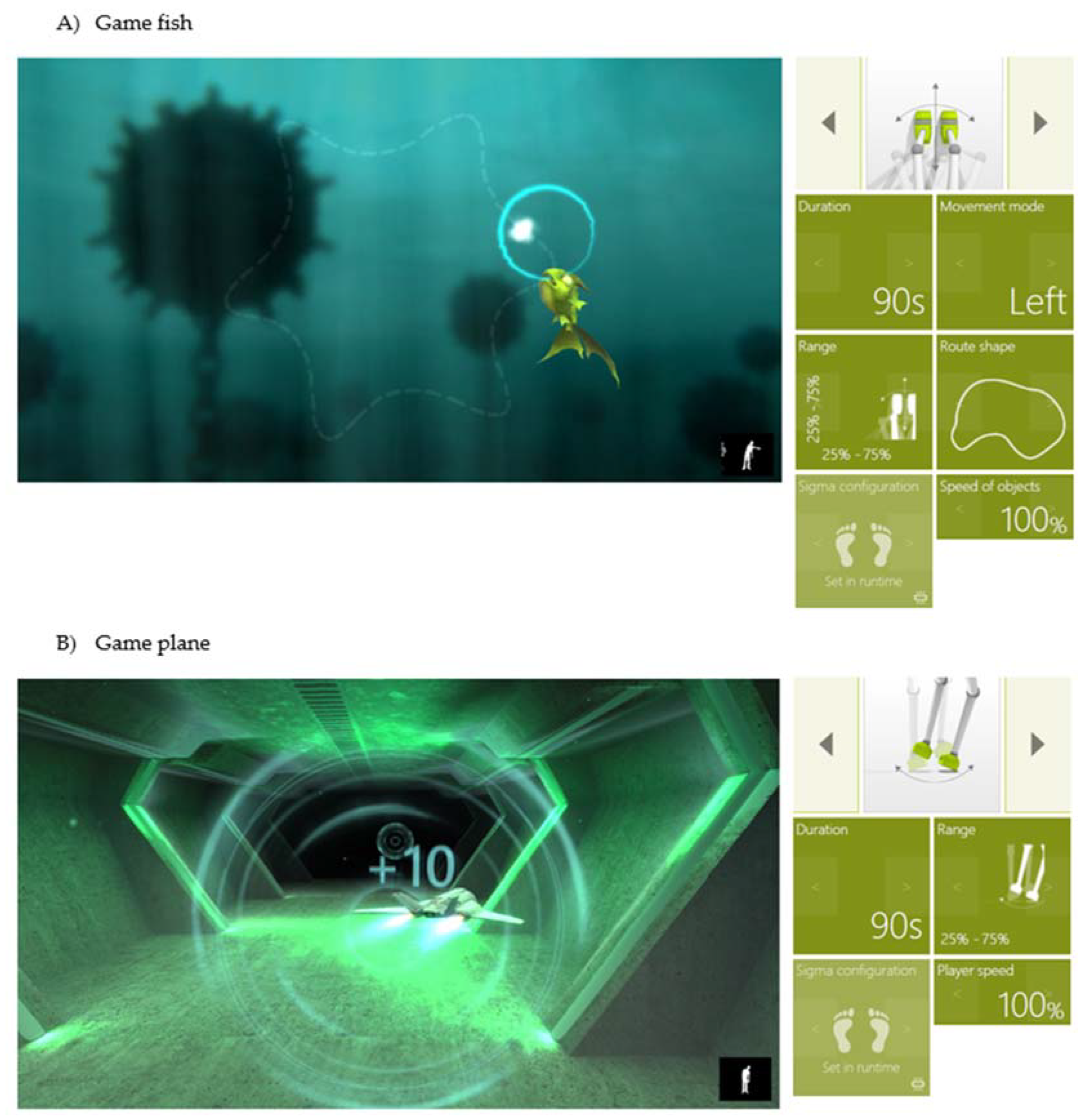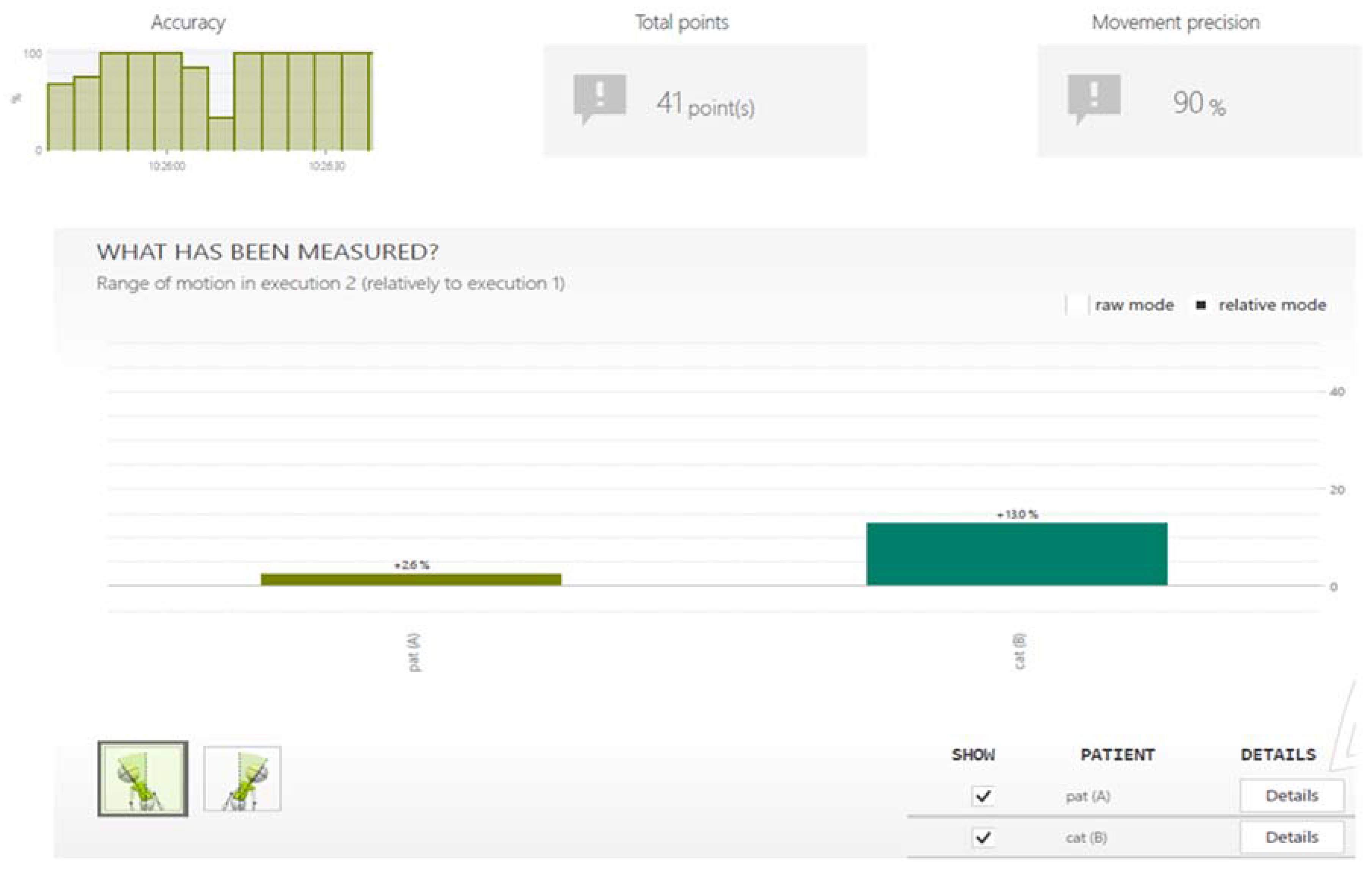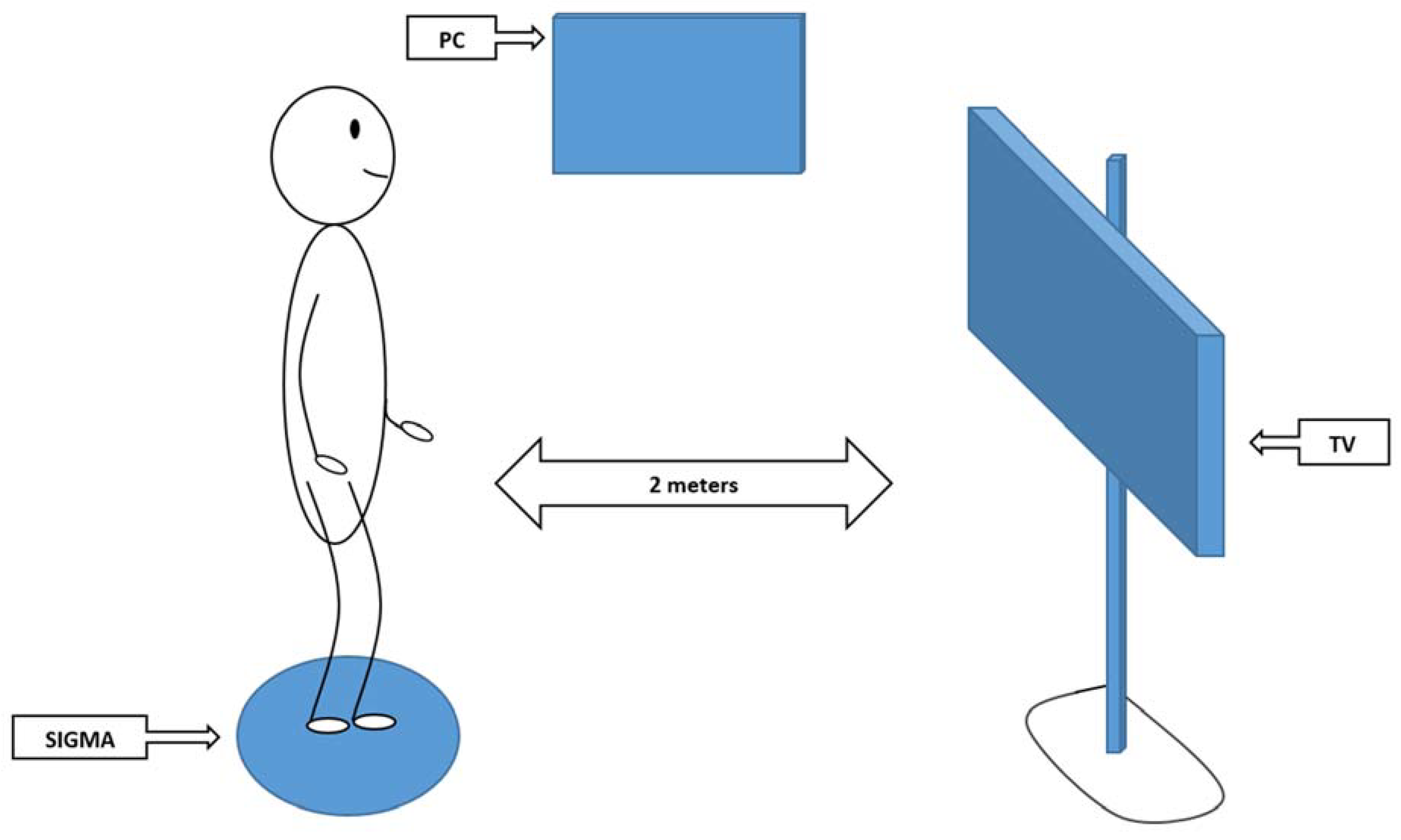The Influence of Proprioceptive Training with the Use of Virtual Reality on Postural Stability of Workers Working at Height
Abstract
1. Introduction
2. Materials and Methods
2.1. Characteristics of the Research Group
- Experimental group (EG)—HW training on a balance platform using VR: initial n = 12;
- Control group (CG)—HW not training on a balance platform using VR: initial n = 12.
2.2. Experimental Procedures
2.2.1. General Course of the Experiment
2.2.2. Initial Measurements
2.2.3. Intervention
2.3. Measurement
2.3.1. Postural Stability (PS)
- EO LT QS—Eyes Open—Low Threat (ground level)—Quiet Standing.
- EO LT DT—Eyes Open—Low Threat—Dual Task (the subject additionally performed a mathematical task, which consisted of counting every 3 numbers down from 200, for the period of the test registration [43])
- EO HT QS—Eyes Open—High Threat (1m above the ground)—Quiet Standing.
- EO HT DT—Eyes Open—High Threat—Dual Task.
2.3.2. Statistical Analysis
3. Results
3.1. Effect of the Intervention on Postural Stability with Eyes Open in Conditions of the Low-High Threat during Quiet Standing or Performing a Dual Task (EO LT QS, EO HT QS, EO LT DT, EO HT DT)
3.2. Effect of the Intervention on Postural Stability with Eyes Closed in Conditions of Low-High Threat during Quiet Standing or Performing a Dual Task (EC LT QS, EC HT QS, EC LT DT, EC HT DT)
4. Discussion
4.1. Effect of Intervention on Postural Stability with Eyes Open
4.2. Effect of the Intervention on Postural Stability with Eyes Open
5. Conclusions
Author Contributions
Funding
Acknowledgments
Conflicts of Interest
References
- Nadhim, E.A.; Hon, C.; Xia, B.; Stewart, I.; Fang, D. Falls from Height in the Construction Industry: A Critical Review of the Scientific Literature. Int. J. Environ. Res. Public Health 2016, 13, 638. [Google Scholar] [CrossRef] [PubMed]
- Umer, W.; Li, H.; Lu, W.; Szeto, G.P.Y.; Wong, A.Y.L. Development of a tool to monitor static balance of construction workers for proactive fall safety management. Autom. Constr. 2018, 94, 438–448. [Google Scholar] [CrossRef]
- Bureau of Labor Statistics (BLS). Bureau of Labor Statistics (BLS). Fatal work injuries, by industry and contractor adjusted industry, by selected industry, 2012. Injuries, Illnesses, and Fatalities, U.S. Dept. of Labor, Washington, DC, 2016. Available online: https://www.bls.gov/opub/mlr/2013/ (accessed on 22 May 2020).
- Occupational Safety & Health Administration (OSHA). Walking-Working Surfaces and Personal Protective Equipment (Fall Protection Systems). Federal Registered The Daily Journal of the United State Government; 2016. Available online: https://www.federalregister.gov/documents/2016/11/18/2016-24557/walking-workingsurfaces-and-personal-protective-equipment-fall-protection-systems (accessed on 22 May 2020).
- MZiOS Regulation 1996 on carrying out medical examinations for workers, the scope of preventive health care for workers, and medical certificates issued for the purposes set out in the Labor Code (Journal of Laws, No.69, item 332).
- Antwi-Afari, M.F.; Li, H.; Seo, J.; Lee, S.H.; Edwards, J.D.; Yu Lok Wong, A. Wearable insole pressure sensors for automated detection and classification of slip-trip-loss of balance events in construction workers. In Proceedings of the Conference Paper Construction Research Congress, New Orleans, Louisiana, 2–4 April 2018. [Google Scholar]
- Koepp, G.A.; Snedden, B.J.; Levine, J.A. Workplace slip, trip and fall injuries and obesity. Ergonomics 2015, 58, 1–6. [Google Scholar] [CrossRef] [PubMed]
- Chander, H.; Kodithuwakku Arachchige, S.N.K.; Hill, C.M.; Turner, A.J.; Deb, S.; Shojaei, A.; Hudson, C.; Knight, A.C.; Carruth, D.W. Virtual-reality-induced visual perturbations impact postural control system behavior. Behav. Sci. 2019, 9, 113. [Google Scholar] [CrossRef] [PubMed]
- Jeter, P.E.; Moonaz, S.H.; Bittner, A.K.; Dagnelie, G. Ashtanga-based yoga therapy increases the sensory contribution to postural stability in visually-impaired persons at risk for falls as measured by the wii balance board: A pilot randomized controlled trial. Public Libr. Sci. 2015, 10, e0129646. [Google Scholar] [CrossRef]
- Nishiike, S.; Okazaki, S.; Watanabe, H.; Akizuki, H.; Imai, T.; Uno, A.; Kitahara, T.; Horii, A.; Takeda, N.; Inohara, H. The effect of visual-vestibulosomatosensory conflict induced by virtual reality on postural stability in humans. J. Med. Investig. 2013, 60, 236–239. [Google Scholar] [CrossRef]
- Smalley, A.; White, S.C.; Burkard, R. The effect of augmented somatosensory feedback on standing postural sway. Gait Posture 2018, 60, 76–80. [Google Scholar] [CrossRef]
- Assländer, L.; Hettich, G.; Mergner, T. Visual contribution to human standing balance during support surface tilts. Hum. Mov. Sci. 2015, 41, 147–164. [Google Scholar] [CrossRef]
- Hsiao, H.; Simeonov, P. Preventing falls from roofs: A critical review. Ergonomics 2001, 44, 537–561. [Google Scholar] [CrossRef]
- Orrell, A.J.; Masters, R.S.; Eves, F.F. Reinvestment and movement disruption following stroke. Neurorehabilit. Neural Repair 2009, 23, 177–183. [Google Scholar] [CrossRef]
- Huffman, J.L.; Horslen, B.C.; Carpenter, M.G.; Adkin, A.L. Does increased postural threat lead to more conscious control of posture? Gait Posture 2009, 30, 528–532. [Google Scholar] [CrossRef] [PubMed]
- Adkin, A.L.; Carpenter, M.G. New insights on emotional contributions to human postural control. Front. Neurol. 2018, 10, 789. [Google Scholar] [CrossRef]
- Zaback, M.; Adkin, A.L.; Carpenter, M.G. Adaptation of emotional state and standing balance parameters following repeated exposure to height-induced postural threat. Sci. Rep. 2019, 9, 12449. [Google Scholar] [CrossRef]
- Cullen, R.H.; Agnew, M.J. Comparing different measures of overall workload in a multimodal postural/auditory dual-task environment. J. Iie Trans. Occup. Ergon. Hum. Factors 2016, 4, 2–3. [Google Scholar] [CrossRef]
- Schnitther, A.J. The Effects of a Cognitive Dual Task on Jump-Landing Mechanics. Master’s Thesis, Ohio University, Athens, OH, USA, 2017. [Google Scholar]
- Shia, Y.; Dua, J.; Ahnb, C.R.; Raganc, E. Impact assessment of reinforced learning methods on construction workers’ fall risk behavior using virtual reality. Autom. Constr. 2019, 104, 197–214. [Google Scholar] [CrossRef]
- Wang, P.; Wu, P.; Wang, J.; Chi, H.L.; Wang, X. A critical review of the use of virtual reality in construction engineering education and training. Int. J. Environ. Res. Public Health 2018, 15, 1204. [Google Scholar] [CrossRef]
- Wilkins, J.R. Construction workers’ perceptions of health and safety training programmes. Constr. Manag. Econ. 2011, 29, 1017–1026. [Google Scholar] [CrossRef]
- Goedert, J.D.; Rokooei, S. Project-based construction education with simulations in a gaming environment. Int. J. Constr. Educ. Res. 2016, 12, 208–223. [Google Scholar] [CrossRef]
- Donath, L.; Rossler, R.; Faude, O. Effects of virtual reality training (exergaming) compared to alternative exercise training and passive control on standing balance and functional mobility in healthy community-dwelling seniors: A meta-analytical review. Sports Med. 2016, 46, 1293. [Google Scholar] [CrossRef]
- Guo, H.; Lia, H.; Chana, G.; Skitmore, M. Using game technologies to improve the safety of construction plant operations. Accid. Anal. Prev. 2012, 48, 204–213. [Google Scholar] [CrossRef]
- Rizzo, A.A. Virtual reality and disability: Emergence and challenge. Disabil. Rehabil. 2002, 4, 567–569. [Google Scholar] [CrossRef]
- Kalron, A.; Fonkatz, I.; Frid, L.; Baransi, H.; Achiron, A. The effect of balance training on postural control in people with multiple sclerosis using the CAREN virtual reality system: A pilot randomized, controlled trial. J. Neuro Eng. Rehabil. 2016, 13, 1–10. [Google Scholar] [CrossRef]
- Ko, Y.; Ha, H.; Bae, Y.H.; Lee, W. Effect of space balance 3D training using visual feedback on balance and mobility in acute stroke patients. J. Phys. Ther. Sci. 2015, 27, 1593–1596. [Google Scholar] [CrossRef]
- Schwenk, M.; Grewal, G.S.; Honarvar, B.; Schwenk, S.; Mohler, J.; Khalsa, D.S.; Najafi, B. Interactive balance training integrating sensor-based visual feedback of movement performance: A pilot study in older adults. J. Neuroeng. Rehabil. 2014, 13, 164. [Google Scholar] [CrossRef]
- Srivastava, A.; Taly, A.B.; Gupta, A.; Kumar, S.; Murali, T. Post-stroke balance training: Role of force platform with visual feedback technique. J. Neurol. Sci. 2009, 287, 89–93. [Google Scholar] [CrossRef] [PubMed]
- Lia, X.; Yib, W.; Chi, H.L.; Wang, X.; Chana, A.P.C. A critical review of virtual and augmented reality (VR/AR) applications in construction safety. Autom. Constr. 2018, 86, 150–162. [Google Scholar] [CrossRef]
- Wang, X.; Li, H.; Wong, J.; Li, H. Construction health and safety training: The utilisation of 4D enabled serious games. J. Inf. Technol. Constr. 2014, 19, 326–335. [Google Scholar]
- Strobach, S.; Frensch, P.A.; Schubert, T. Video game practice optimizes executive control skills in dual-task and task switching situations. Acta Psychol. 2012, 140, 13–24. [Google Scholar] [CrossRef]
- Rebenitsch, L.; Owen., O. Review on cybersickness in applications and visual displays. Virtual Reality 2016, 20, 101–125. [Google Scholar] [CrossRef]
- Nalivaikoa, E.; Davis, S.L.; Blackmore, J.L.; Vakulin, A.; Nesbitt, K.W. Cybersickness provoked by head-mounted display affects cutaneous vascular tone, heart rate and reaction time. Physiol. Behav. 2015, 151, 583–590. [Google Scholar] [CrossRef]
- Ciou, S.H.; Hwang, Y.S.; Chen, C.C.; Chen, S.C.; Chou, S.W.; Chen, Y.L. Balance training using an interactive game to enhance the use of the affected side after stroke. J. Phys. Ther. Sci. 2015, 27, 3855–3861. [Google Scholar] [CrossRef] [PubMed][Green Version]
- Kümmel, J.; Kramer, S.A.; Giboin, L.S.; Gruber, M. Specificity of balance training in healthy individuals: A systematic review and meta-analysis. Sports Med. 2016, 46, 1261–1271. [Google Scholar]
- Maciaszek, J. Effects of Posturographic Platform Biofeedback Training on the Static and Dynamic Balance of Older Stroke Patients. J. Stroke Cerebrovasc. Dis. 2018, 27, 1969–1974. [Google Scholar] [CrossRef] [PubMed]
- Amritha, N.; Mahima, M.M.; Namitha, K.; Unnikrishnan, R.; Harish, M.T.; Sankaran Ravi, M.D.; Bhavani, R.R. Design and development of balance training platform and games for people with balance impairments. In Proceedings of the 2016 International Conference on Advances in Computing, Communications and Informatics (ICACCI), Jaipur, India, 21–24 September 2016. [Google Scholar] [CrossRef]
- World Medical Association. World Medical Association Declaration of Helsinki Ethical Principles for Medical Research Involving Human Subjects. J. Am. Med Assoc. 2013, 310, 2191–2194. [Google Scholar] [CrossRef] [PubMed]
- Bassett, D.R.; Troiano, R.P.; McClain, J.J.; Wolff, D.L. Accelerometer-based physical activity: Total volume per day and standardized measures. Med. Sci. Sports Exerc. 2015, 47, 833–838. [Google Scholar] [CrossRef] [PubMed]
- Mynarski, W.; Grabara, M.; Rozpara, M.; Nawrocka, A.; Powerska-Didkowska, A.; Borek, Z. Energy expenditure of nordic walking and conventional walking assessed by accelerometer. Biomed. Hum. Kinet. 2014, 6, 109–115. [Google Scholar] [CrossRef]
- Sample, R.B.; Jackson, K.; Kinney, A.L.; Diestelkamp, W.S.; Reinert, S.S.; Bigelow, K.E. Manual and cognitive dual tasks contribute to fall-risk differentiation in posturography measures. J. Appl. Biomech. 2016, 32, 541–547. [Google Scholar] [CrossRef]
- Bizid, R.; Margnes, E.; François, Y.; Jully, J.; Gonzalez, G.; Dupui, P.; Paillard, T. Effects of knee and ankle muscle fatigue on postural control in the unipedal stance. Eur. J. Appl. Physiol. 2009, 106, 375–380. [Google Scholar] [CrossRef] [PubMed]
- Stemplewski, R.; Maciaszek, J.; Salamon, A.; Tomczak, M.; Osiński, W. Effect of moderate physical exercise on postural control among 65–74 year-old men. Arch. Gerontol. Geriatr. 2012, 54, 279–283. [Google Scholar] [CrossRef]
- Esculier, J.F.; Vaudrin, J.; Bériault, P.; Gagnon, K.; Tremblay, L.E. Home-based balance training programme using Wii Fit with balance board for Parkinson’s disease: A pilot study. J. Rehabil. Med. 2012, 44, 144–150. [Google Scholar] [CrossRef]
- Carozza, L.; Bosché, F.; Abdel-Wahab, M. Image-based location for an indoor VR-AR Construction training system. In Proceedings of the 13th International Conference on Construction Applications of Virtual Reality, CONVR 2013, London, UK, 30–31 October 2013; pp. 363–372. [Google Scholar]
- Karle, J.W.; Watter, S.; Shedden, J.M. Task switching in video game players: Benefits of selective attention but not resistance to proactive interference. Acta Psychol. 2010, 34, 70–78. [Google Scholar] [CrossRef] [PubMed]
- Cain, M.S.; Landau, A.N.; Shimamura, A.P. Action video game experience reduces the cost of switching tasks. Atten Percept Psychophys 2012, 74, 641–647. [Google Scholar] [CrossRef] [PubMed]
- Green, C.S.; Sugarman, M.A.; Medford, K.; Klobusicky, E.; Bavelier, D. The effect of action video game experience on task-switching. Comput. Hum. Behav. 2012, 28, 984–994. [Google Scholar] [CrossRef] [PubMed]
- Colzato, L.S.; van den Wildenberg, V.P.M.; Zmigrod, S.; Hommel, B. Action video gaming and cognitive control: Playing first person shooter games is associated with improvement in working memory but not action inhibition. Psychol. Res. 2013, 77, 234–239. [Google Scholar] [CrossRef]
- Hutt, K.; Redding, E. The effect of an eyes-closed dance-specific training program on dynamic balance in elite pre-professional ballet dancers: A randomized controlled pilot study. J. Danc. Med. Sci. 2014, 18, 3–11. [Google Scholar] [CrossRef]
- Mhatre, P.V.; Vilares, I.; Stibb, S.M.; Albert, M.V.; Pickering, L.; Marciniak, C.M.; Kording, K.; Toledo, S. Wii Fit balance board playing improves balance and gait in Parkinson’s disease. PmR 2013, 5, 769–777. [Google Scholar] [CrossRef]
- van Diest, M.; Stegenga, J.; Wörtche, H.J.; Verkerke, G.J.; Postema, K.; Lamoth, C.J. Exergames for unsupervised balance training at home: A pilot study in healthy older adults. Gait Posture 2015, 44, 161–167. [Google Scholar] [CrossRef]
- Green, C.S.; Bavelier, D. Action video game training for cognitive enhancement. Curr. Opin. Behav. Sci. 2015, 4, 103–108. [Google Scholar] [CrossRef]
- Angelov, V. Improving balance stability through application of training program in stressful conditions via virtual reality glasses and glasses simulating alcohol use. Int. J. Appl. Sports Sci. 2018, 2, 43–58. [Google Scholar] [CrossRef]
- Duque, G.; Boersma, D.; Loza-Diaz, G.; Hassan, S.; Suarez, H.; Geisinger, D.; Suriyaarachchi, P.; Sharma, A.; Demontiero, O. Effects of balance training using a virtual-reality system in older fallers. Clin. Interv. Aging 2013, 8, 257–263. [Google Scholar] [CrossRef]





| Variable | M (sd) EG | M (sd) CG | t df = 19 | p |
|---|---|---|---|---|
| Age [years] | 34.00(8.04) | 37.27(7.87) | −0.94 | 0.36 |
| Body height (m) | 1.81(0.04) | 1.81(0.06) | −0.37 | 0.72 |
| Body weight (kg) | 88.52(9.64) | 88.85(13.14) | −0.06 | 0.95 |
| BMI [kg/m2] | 27.13(2.32) | 26.97(3.40) | 0.12 | 0.90 |
| PA-E [cals/day/kg] | 9.31(9.25) | 11.63(9.14) | −0.57 | 0.57 |
| Pre | Post | |||||||||
|---|---|---|---|---|---|---|---|---|---|---|
| Variable | M (sd) EG | M (sd) CG | M (sd) EG | M (sd) CG | Interaction F(p) | η2 | Group F(p) | η2 | Time F(p) | η2 |
| Low threat | ||||||||||
| SP-[mm] | 193.1(44.32) | 189.4(21.87) | 166.2(36.27) | 179.7(25.98) | 4.02(>0.05) | 0.17 | 0.11(>0.05) | 0.01 | 20.47(<0.001) | 0.52 |
| SPAP-[mm] | 153.7(36.55) | 148.1(21.70) | 131.1(28.65) | 138.4(23.29) | 2.66(>0.05) | 0.12 | 0.005(>0.05) | 0.00 | 16.82(<0.001) | 0.47 |
| SPML-[mm] | 87.1(21.58) | 87.9(17.38) | 76.2(17.16) | 85.7(18.19) | 5.47(<0.05) | 0.22 | 0.38(>0.05) | 0.02 | 12.35(<0.01) | 0.39 |
| High threat | ||||||||||
| SP-[mm] | 210.0(48.01) | 218.1(40.82) | 172.7(49.91) | 220.5(38.51) | 14.28(<0.001) | 0.43 | 2.25(>0.05) | 0.11 | 11.09(<0.01) | 0.37 |
| SPAP-[mm] | 169.7(40.0) | 176.3(32.35) | 137.1(39.53) | 175.6(27.59) | 8.01(<0.01) | 0.29 | 2.51(>0.05) | 0.12 | 8.75(<0.01) | 0.31 |
| SPML-[mm] | 90.5(24.34) | 93.8(27.09) | 76.1(21.73) | 98.(30.63) | 24.78(<0.000) | 0.57 | 11.28(>0.05) | 0.06 | 6.52(<0.01) | 0.25 |
| Pre | Post | |||||||||
|---|---|---|---|---|---|---|---|---|---|---|
| Variable | M (sd) EG | M (sd) CG | M (sd) EG | M (sd) CG | Interaction F(p) | η2 | Group F(p) | η2 | Time F(p) | η2 |
| Low threat | ||||||||||
| SP-[mm] | 201.4(35.83) | 211.9(47.06) | 156.5(36.72) | 207.3(51.90) | 12.50(<.001) | 0.40 | 2.83(>0.05) | 0.13 | 19.0(<0.000) | 0.50 |
| SPAP-[mm] | 163.0(31.89) | 172.8(42.08) | 122.5(29.22) | 170.6(48.76) | 12.38(<0.01) | 0.39 | 3.18(>0.05) | 0.14 | 15.29(<0.001) | 0.44 |
| SPML-[mm] | 87.2(15.02) | 89.5(24.73) | 71.9(18.69) | 85.7(21.43) | 7.29(<0.01) | 0.28 | 0.87(>0.05) | 0.04 | 20.05(<0.000) | 0.51 |
| High threat | ||||||||||
| SP-[mm] | 210.6(33.61) | 217.5(35.95) | 177.5(38.32) | 232.5(42.85) | 35.65(<0.0000) | 0.65 | 3.7(>0.05) | 0.16 | 5.03(<0.05) | 0.21 |
| SPAP-[mm] | 172.9(28.58) | 177.8(29.21) | 142.7(28.16) | 191.8(33.85) | 31.72(<0.0000) | 0.62 | 4.63(<0.05) | 0.19 | 4.29(>0.05) | 0.18 |
| SPML-[mm] | 87.8(15.47) | 91.5(20.39) | 77.7(17.90) | 95.6(23.42) | 21.17(<0.0001) | 0.52 | 1.63(>0.05) | 0.07 | 3.76(>0.05) | 0.16 |
| Pre | Post | |||||||||
|---|---|---|---|---|---|---|---|---|---|---|
| Variable | M (sd) EG | M (sd) CG | M (sd) EG | M (sd) CG | Interaction F(p) | η2 | Group F(p) | η2 | Time F(p) | η2 |
| Low threat | ||||||||||
| SP-[mm] | 293.2(81.55) | 272.2(51.41) | 224.4(55.28) | 270.5(48.19) | 14.17(<0.001) | 0.43 | 0.26(>0.05) | 0.01 | 15.71(<0.001) | 0.45 |
| SPAP-[mm] | 254.8(72.31) | 234.0 (54.31) | 195.2(48.29) | 235.0(63.04) | 12.42(<0.01) | 0.39 | 0.14(>0.05) | 0.01 | 11.62(<0.01) | 0.38 |
| SPML-[mm] | 101.8(30.98) | 105.2(31.39) | 84.2(22.98) | 107.6(34.11) | 8.95(<0.01) | 0.32 | 1.1(>0.05) | 0.55 | 5.16(<0.05) | 0.21 |
| High threat | ||||||||||
| SP-[mm] | 279.4(70.73) | 283.3(56.27) | 212.1(68.06) | 296.4(65.15) | 17.24(<0.000) | 0.47 | 2.72(>0.05) | 0.12 | 7.86(<0.01) | 0.29 |
| SPAP-[mm] | 238.2(64.39) | 241.2(51.98) | 172.4(61.38) | 252.5(61.96) | 15.72(<0.001) | 0.45 | 2.92(>0.05) | 0.13 | 7.9(<0.01) | 0.29 |
| SPML-[mm] | 103.4(28.79) | 104.6(23.30) | 90.3(27.59) | 109.6(25.18) | 7.33(<0.01) | 0.27 | 0.88(>0.05) | 0.04 | 1.44(>0.05) | 0.07 |
| Pre | Post | |||||||||
|---|---|---|---|---|---|---|---|---|---|---|
| Variable | M (sd) EG | M (sd) CG | M (sd) EG | M (sd) CG | Interaction F(p) | η2 | Group F(p) | η2 | Time F(p) | η2 |
| Low threat | ||||||||||
| SP-[mm] | 263.8(49.43) | 259.9(53.15) | 217.2(42.11) | 257.3(73.45) | 7.36(<0.01) | 0.27 | 0.6(>0.05) | 0.03 | 9.23(<0.01) | 0.33 |
| SPAP-[mm] | 225.1(49.19) | 224.2(50.23) | 186.2(39.92) | 224.7(68.33) | 6.15(<0.05) | 0.24 | 0.74(>0.05) | 0.04 | 5.82(<0.05) | 0.23 |
| SPML-[mm] | 96.7(13.49) | 97.73(30.62) | 79.7(17.11) | 100.6(40.43) | 20.49(<0.001) | 0.52 | 0.83(>0.05) | 0.04 | 10.26(<0.01) | 0.35 |
| High threat | ||||||||||
| SP-[mm] | 256.8(61.18) | 263.1(65.90) | 224.5(69.95) | 270.4(78.96) | 4.15(>0.05) | 0.17 | 0.82(>0.05) | 0.04 | 1.65(>0.05) | 0.08 |
| SPAP-[mm] | 219.3(57.86) | 222.7(60.54) | 179.6(63.29) | 230.4(73.45) | 6.6(<0.05) | 0.25 | 1.04(>0.05) | 0.05 | 3.0(>0.05) | 0.14 |
| SPML-[mm] | 95.3(19.49) | 99.4(25.17) | 85.8(20.20) | 100.6(26.46) | 3.3(>0.05) | 0.14 | 0.94(>0.05) | 0.05 | 1.99(>0.05) | 0.09 |
© 2020 by the authors. Licensee MDPI, Basel, Switzerland. This article is an open access article distributed under the terms and conditions of the Creative Commons Attribution (CC BY) license (http://creativecommons.org/licenses/by/4.0/).
Share and Cite
Cyma-Wejchenig, M.; Tarnas, J.; Marciniak, K.; Stemplewski, R. The Influence of Proprioceptive Training with the Use of Virtual Reality on Postural Stability of Workers Working at Height. Sensors 2020, 20, 3731. https://doi.org/10.3390/s20133731
Cyma-Wejchenig M, Tarnas J, Marciniak K, Stemplewski R. The Influence of Proprioceptive Training with the Use of Virtual Reality on Postural Stability of Workers Working at Height. Sensors. 2020; 20(13):3731. https://doi.org/10.3390/s20133731
Chicago/Turabian StyleCyma-Wejchenig, Magdalena, Jacek Tarnas, Katarzyna Marciniak, and Rafał Stemplewski. 2020. "The Influence of Proprioceptive Training with the Use of Virtual Reality on Postural Stability of Workers Working at Height" Sensors 20, no. 13: 3731. https://doi.org/10.3390/s20133731
APA StyleCyma-Wejchenig, M., Tarnas, J., Marciniak, K., & Stemplewski, R. (2020). The Influence of Proprioceptive Training with the Use of Virtual Reality on Postural Stability of Workers Working at Height. Sensors, 20(13), 3731. https://doi.org/10.3390/s20133731






